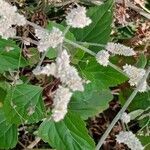Perennial herb, often more or less woody at base, ¾-2 m high, erect or ± clambering, branched or not; stem terete, its upper part densely clothed with appressed or patent soft white hairs, gradually glabrescent downward; internodes often longer than 3 cm. Leaves opposite or alternate (often on a single specimen), ovate-elliptic, oblong or lanceolate from a cuneate or contracted base, usually acute, mucronate, on both surfaces (especially so beneath) rather densely clothed with appressed white hairs, more or less tinged with purple (type) or green, 15-75 by 6-45 mm; petiole 3-10 mm. Spikes solitary or fascicled, partly in axils of ordinary leaves, partly in those of bracts and then often collected into a lax terminal spike or raceme with a well-developed terminal spike, cylindric, usually with a conical apex, ¾-5 cm long, more or less tinged with purple or sordidly white, rarely pure white. Flowers softly membranous, (☿)(♀); bracts and bracteoles ovate, mucronate, externally pilose but not very densely so, rarely glabrous, acute 1-1½ mm long. Tepals oblong, acute, externally pilose but not very densely so, 2-2½ mm long; 2 outer ones minutely mucronate. Stamens slightly more than half as long as perianth. Style totalling ± ½ mm; stigma entire or very slightly 2-lobed with rounded lobes. Fruiting spike very dense and rather thick, not easily breaking up. Utricle fully 1 mm diam. Seed ¾-1 mm diam., shining brownish black.
More
Herbs perennial. Stem erect or slightly stoloniferous, simple or branched. Leaves ovate-elliptic, oblong, or lanceolate, 1.5-8 × 0.5-3.5 cm. Inflorescences white or purple sericeous. Bracts, bracteoles, and tepals densely white lanose or puberulous abaxially. Tepals white or pink. Pseudostaminodes triangular. Utricles ovate, glabrous. Seeds reniform. Fl. Apr-Jun, fr. Aug-Oct. 2n = 42.
A deciduous herb. It grows 0.4-1 m tall. The stems are weak and straggling. They are rounded and have a channel. They are velvety with white hairs. The leaves have leaf stalks. The leaves are 2.5-10 cm long and 1-5 cm wide. They are oval to sword shaped. They have grey hairs on both surfaces. The flowers are whitish. The fruit is a capsule 1 mm long.
Especially in periodically dry areas, in Java 5-200 m, in sunny or moderately shaded dry localities, brushwood, hedges, neglected premises, locally often numerous. The purple-tinged typical form is sometimes cultivated for medicinal purpose.
More
A tropical plant. It grows on hillsides and open forests between 1,100-2,300 m above sea level. It grows in dry places in Nepal to about 1400 m altitude.
Locally common in abandoned fields, brushwood and hedges, at elevations up to 200 metres in Java but ascending to 2,000 metres in Indo-China.

